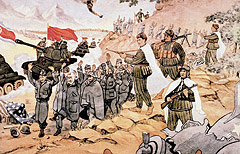The driest area in the country
The Greater North spans the regions of Arica y Parinacota, Tarapaca and Antofagasta. It is Chile’s most arid geographical area and home to the Atacama desert (the driest desert in the world). Nevertheless, there are valleys, oases (like Azapa valley and Pica oasis), ravines and saltpans. This area is the epitome of mining, especially copper mining.
The zone has great biodiversity; the species that best represent the north are protected in National Parks and Monuments like Lauca, Isluga and the Surire Saltpan.
The main cities are Arica, Iquique and Antofagasta. They are all found along the coastline and make for great beaches and ports. In addition, the Greater North’s physical characteristics make for beautiful landscapes. For example, in the areas surrounding San Pedro de Atacama, you have the valley of the Moon and its incredible sand and stone formations; the Atacama Saltpan with its over 300,000 hectares; the geysers of El Tatio, as well as numerous hot springs, like Mamiña and Puritama.
This is a land of great archeological wealth. The geoglyphs of Pintado Hill, Azapa and Lluta, petroglyphs, paintings, cave and rock art and the Quitor and Lasana pucaras all show the advanced level of development attained by the area’s pre-hispanic cultures.
Other treasures of heritage include the old Santa Laura and Humberstone saltpeter works in the Region of Tarapaca, and the Maria Elena and Baquedano offices in the region of Antofagasta. These spots represent the past glory days of the saltpeter boom of the late XIX and early XX century.
Calama city is a main part of the mining sector. It sprung forth thanks to the mining activities of Chuquicamata, the world’s largest open-pit copper mine.







 Termina la Guerra de Corea
Termina la Guerra de Corea